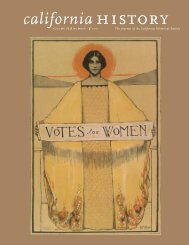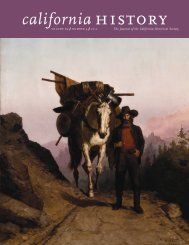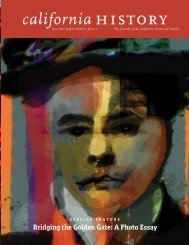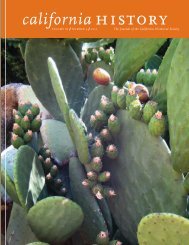Volume 90, Number 1 - California Historical Society
Volume 90, Number 1 - California Historical Society
Volume 90, Number 1 - California Historical Society
You also want an ePaper? Increase the reach of your titles
YUMPU automatically turns print PDFs into web optimized ePapers that Google loves.
54<br />
by 1893, the oregonbred<br />
poet had<br />
penned “Columbus”<br />
(“Sail on! Sail<br />
on! and on!”). . . .<br />
His “shelf of the<br />
mountain” was<br />
slowly beginning<br />
to resemble the<br />
“hillside bohemia”<br />
he had been<br />
bruiting about since<br />
the early 18<strong>90</strong>s.<br />
writers, Luke Pease and James H. MacLafferty,<br />
pitching hay. The sturdier among Miller’s circle<br />
fitted rocks for his network of monuments: the<br />
pyramid to Moses, the tower to Robert Browning,<br />
the turret to John C. Frémont, and, grandest<br />
of all, the funeral pyre intended for Miller’s own<br />
personal use. 44<br />
By 1893, the Oregon-bred poet had penned<br />
“Columbus” (“Sail on! Sail on! and on!”), the<br />
verses that would, on October 12 each year, make<br />
him the bane of at least two generations of children.<br />
His “shelf of the mountain” was slowly<br />
beginning to resemble the “hillside Bohemia” he<br />
<strong>California</strong> History • volume <strong>90</strong> number 1 2012<br />
had been bruiting about since the early 18<strong>90</strong>s.<br />
One of the first to arrive was his disciple Edwin<br />
Markham. As early as 1888, a solitary Miller had<br />
written to Markham in Placerville in an effort to<br />
attract a sympathetic and muscular workmate to<br />
the barren hillside he termed a “doleful, grewsome<br />
[sic] place.” 45 Four years later, after the<br />
electrification of the tram line, Markham, who<br />
for about three years had been living downtown<br />
near the Oakland elementary school where he<br />
was principal, moved within a half-mile of the<br />
Hights. 46 There, in 1899, he produced “Man with<br />
the Hoe,” one of the most popular and lucrative<br />
poems of all times.<br />
About the time Markham took the job in Oakland,<br />
the first of Miller’s long line of Japanese<br />
youths began to appear. They were of two kinds,<br />
well-to-do students on their way home from Ivy<br />
League colleges and poorer young men who may<br />
have been working elsewhere in menial jobs.<br />
Both types raised the ire of the locals. (In his<br />
rambling semiautobiography, The Building of the<br />
City Beautiful, Miller described a confrontation<br />
with a “committee for the protection of white<br />
labor,” whose threats forced some of the early<br />
live/work residents to leave. 47 ) Elbert Hubbard,<br />
recalling his late 1<strong>90</strong>2 visit, reported on the effect<br />
of these outlanders on the rough slopes above<br />
Dimond: “Soon a whole little village smiled upon<br />
us from a terraced outlook, that seemed surrounded<br />
and shut in by tall pines. The houses<br />
were about as large as dry goods cases—say eight<br />
by twelve. There were a dozen of them . . . of all<br />
sorts and color and shapes.” 48<br />
Musing on the same sight, Jim Whitaker’s<br />
daughter Elsa remembered visiting “the beautiful<br />
little Japanese paper houses up through the<br />
woods.” She described them as “well made”<br />
and mostly composed of paper. 49 Hubbard was<br />
met by “an Oriental, all dressed in white,” who<br />
escorted him to his cottage. On his one and only<br />
stay at the Hights, Charles Warren Stoddard, a<br />
founder with Coolbrith and Harte of the Overland









